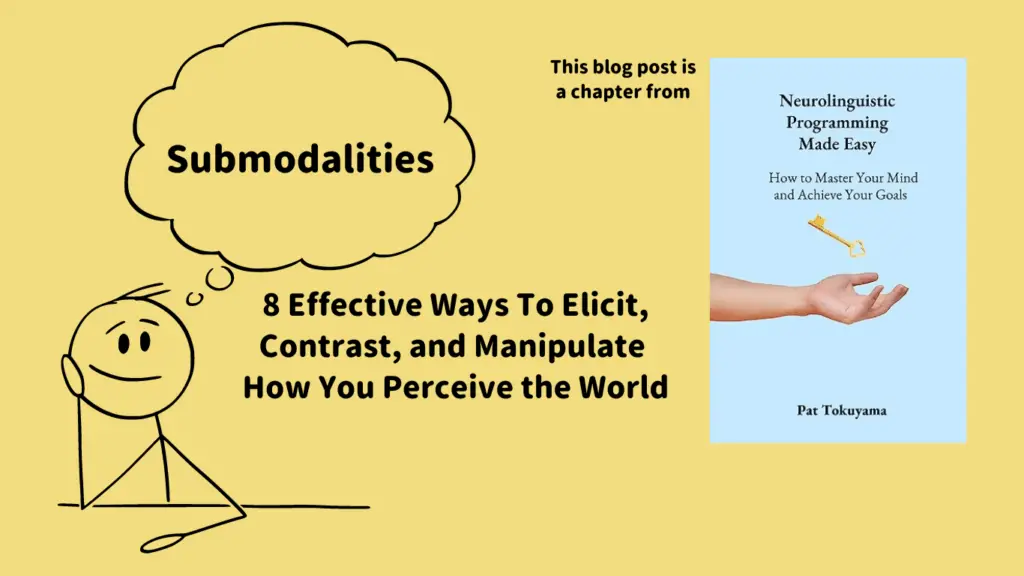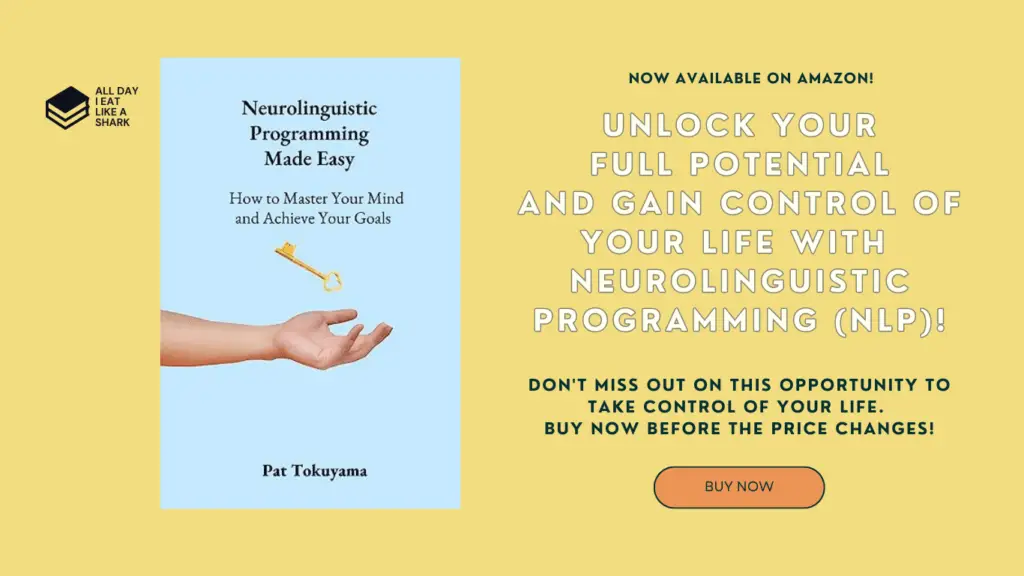
This is the third chapter of the Neurolinguistic Programming Made Easy: How to Master Your Mind and Achieve Your Goals by Pat Tokuyama
Guide to the Good Stuff
Have you ever noticed that some sensory experiences have more impact on you than others? For example, some memories make you feel more happy or sad than others. Some images make you feel more excited or bored than others. Some sounds make you feel more relaxed or tense than others.
These differences are due to submodalities, the fine distinctions or qualities of your sensory experiences.
What are submodalities?
Submodalities are the way you represent things in your mind through your senses: visual (seeing), auditory (hearing), kinesthetic (feeling), olfactory (smelling), or gustatory (tasting).
Submodalities affect how you perceive the world, how you learn, how you remember, and how you relate to others. Knowing your submodalities and how to change them can help you change how you feel and think.
How to elicit submodalities
One way to elicit submodalities is to pay attention to the details of your sensory experiences when you recall or imagine something. For example, if you remember or imagine a happy memory, you can ask yourself question. Here are a few examples for each:
1. Visual submodalities
Is the image in color or black and white? Is it bright or dim? Is it clear or blurry? Is it big or small? Is it close or far? Is it moving or still? Is it framed or panoramic? Are you associated (seeing through your own eyes) or dissociated (seeing yourself from outside)?
2. Auditory submodalities
Is the sound loud or quiet? Is it clear or muffled? Is it high-pitched or low-pitched? Is it fast or slow? Is it rhythmic or erratic? Is it continuous or intermittent? Is it internal (in your head) or external (in your ears)? Is it mono or stereo?
3. Kinesthetic submodalities
Is the feeling warm or cold? Is it light or heavy? Is it soft or hard? Is it smooth or rough? Is it pleasant or unpleasant? Is it intense or mild? Is it constant or changing? Is it localized (in one part of your body) or global (in your whole body)?
You can also elicit submodalities for other senses, such as olfactory and gustatory, by asking similar questions about the smell and taste of something.
How to contrast submodalities
Another way to elicit submodalities is to contrast them with the submodalities of another sensory experience that impacts you differently.
For example, suppose you want to evoke the submodalities of a happy memory. In that case, you can contrast them with the submodalities of a sad memory. You can ask yourself questions like:
- What’s different about the image of the happy memory and the image of the sad memory?
- What’s different about the sound of the happy memory and the sound of the sad memory?
- What’s different about the feeling of the happy memory and the feeling of the sad memory?
By contrasting submodalities, you can identify the key differences that make one experience more positive or negative than another.
How to manipulate submodalities
One of the most useful applications of NLP is manipulating submodalities. Manipulating submodalities means changing the details of your sensory experiences to change how you feel and think. Using submodalities can help you enhance or diminish the impact of a memory, belief, or emotion.
To manipulate submodalities, you need to use your imagination and creativity. You need to experiment with changing different aspects of your sensory experiences and notice how they affect your state. You need to use the following techniques:
1. Swish
A technique that helps you replace an unwanted state with a desired state by rapidly switching between two images representing them.
For example, suppose you want to replace fear with confidence. In that case, you can swish between an image of yourself being fearful and an image of yourself being confident.
2. Mapping across
A technique that helps you transfer one experience’s submodalities to another to change its impact.
For example, suppose you want to make a sad memory less sad. In that case, you can map across the submodalities of a neutral memory to the sad memory.
3. Change history
A technique that helps you change your past experiences by changing their submodalities.
For example, suppose you want to change a traumatic memory. In that case, you can change its submodalities to make it less intense and distant.
4. Future pacing
A technique that helps you create your future experiences by creating their submodalities. For example, suppose you want to create a successful outcome. In that case, you can create its submodalities to make it more vivid and realistic.
By manipulating submodalities, you can change how you feel and think about anything.
Summary
In this chapter, you learned about submodalities, the fine distinctions or qualities of your sensory experiences. You learned how to elicit submodalities by paying attention to the details of your sensory experiences or by contrasting them with other sensory experiences. You also learned how to manipulate submodalities by changing the details of your sensory experiences to change how you feel and think.
In the next chapter, you’ll learn about strategies which are sequences of internal and external representations that lead to a specific outcome.
